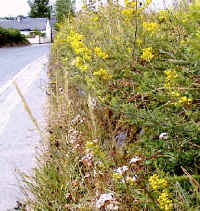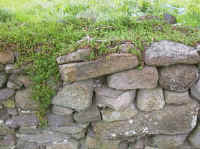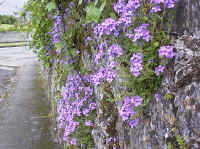|
Native Origin Irish Wildflower Seed Mixtures: Ecotype
Range
Product Code: EC11
Product Name: Wild Flora for Stone Walls and Green Roofs.
This
seed mixture is a specialty in the range. (EDEN Project Roof Garden Choice)
Sod Roof Gardens:
DBN has supplied specialist mixtures for 'Green Roofs'' since our start up
in 1990, indeed we have used the following species to cover
roofs for The Office of Public Works on Heritage Centres at the New Grange Centre which is
an example of one of our sod roof gardens
Growing flora on 'Green or Sod' roofs or on roof gardens is now becoming
increasingly popular, we have supplied major protects world-wide and
have a number of recent customer in Ireland who sow green roofs.
Stone Wall Flora
Establishing a flora on a wall
requires certain conditions, the best is a flat capped wall with
limestone soil or peat. In addition a paste can be made of dried seaweed
and manual, some use porridge to splatter across dry stone wall faces,
where there is crevices between the stonework.
Species List: This
species list shows species from which a mixture may be designed. Limited
stock available unless grown to order.
Common
Bent Grass
Burnet Saxifrage*
Centaury*
Wild Chamomile*
Corn Pansy*
Cowslip
Eyebright*
Lady's Bedstraw
Ox-eye Daisy
Red Bartsia*
Yellow Rattle*
Selfheal
Sheep's Bit Scabious
White Stonecrop
Blackstonia*
Fairy Foxglove
Sea Campion
Ivy Leaved Toadflax
Quaking Grass
Wall Pennywort
Storksbill*
Thyme (Wild)
Sweet Violet
Dog Violet
Allium carinatum
Harebell
Cat's Ear
Corn Spurry*
Fairy Flax
Lesser Yellow Clover or 'shamrock'*
*Denotes
a species that is either of diminished national geno-type or specific to
only a few sites, or who's habitat is increasingly threatened, or the
species is uncommon, rare, becoming rare, is endangered, reintroduced or
saved from extinction.
In all cases, your purchase contributes to DBN's work of creating crops
of Conservation Grade - Native Origin Wildflora. You help us to inform
and pay land-owners to manage native species and to assist DBN in
handing on our heritage for another generation.
By growing (some will be difficult) these and all other species, you
directly help to conserve national and global Biodiversity and protect
wildlife. You should also consider yourself another Irish wildflower
grower.
Product
Warning: While
this Ecotype mixture contains the seed of edible and herbal species, DBN
recommend that this mixture is not for human or animal consumption.

This
photograph is one day in the life of an ever changing ecology.
Seed
Mixture Specifications:
Origin: Native Irish Origin, Wildflower Seed Mixture. EC11
Suitable for soil type: All types of soil, Clay, Loam, Sand,
Light Soil, preferably not heavy soil
Moisture Level: Dry, Normal, Moist, but not Wet
pH range: Best between 5.5 - 7.9
Aspect: Sunny or slightly shaded for part of the day.
Morphology:
Life Cycle: Annual / Biennial /
Perennial.
Height Range: <2cm to >60cm
Flowering Period: April to August.
Fertility Range: Avoid fertile soil.
Wintergreen: Yes, depends on situation and if sown with grass.
The main species which should persist in this
mixture:
Common Bent Grass, Cowslip, Lady's Bedstraw, Ox-eye Daisy, Ivy Leaved Toadflax,
Selfheal,
Sheep's Bit Scabious, Lesser/Yellow Clover 'shamrock'.
Annual
Species: Blackstonia, Century, Sand Spurry, Corn Spurry, Fairy Flax, Eyebright, Corn Pansy,
Red Bartsia, Yellow Rattle.
Biennial Species: Storksbill,

Rare, unusual, and feature species: White Stonecrop, Burnet Saxifrage, Century, Wild
Chamomile, Sea
Campion, Ivy Leaved Toadflax, Quaking Grass, Wall Pennywort,
Thyme (Wild), Sweet Violet, Dog Violet, Allium carinatum, Harebell, Cat's Ear,
Fairy Foxglove,
Wallflower.
Species which will grow if the conditions are ideal: Wallflower, White Stonecrop, Harebell, Wall Pennywort,
Thyme (Wild).
Species which will be affected by management: All. Every
situation will encourage different species, however the simple rule is
do not let anyone species dominate.
Additional species which could be added to this mixture as individual species of seeds or plants:
Purple Toadflax and Wall Valerian, Seek advice it depends on where and on what it is sown.
Design
Notes: Please
ask for 'Bespoke mixtures' to best suit your specific project
.
Sowing Specification:
As Normal, Splatter, hydra-sow or roll or rake into surface to
keep out of reach from birds.
Soil Preparation:
Walls and roofs will require specialist advice.
Ensure a totally weed
free fine tilt or press the seed into clean soil.
Optimum Sowing Time: Early spring, early
autumn, when the soil is warm.
Sowing Conditions:
Normal, do not let the site dry out once sown, wall tops dry out in
hours, 'sod roofs' suffer wind desiccation and this will kill emerging
seedlings.
Sowing Method: 'By hand' is recommended, if
using seed spreaders be careful to insure the small varieties of seed do
not drop to the bottom of the seed spreader and get sown all in the one
place. Can be Hydrasown.
Fertiliser: None, unless very poor
fertility such as sand or limestone dry fill. Powdered or liquid seaweed will aid germination.
Seed Sowing Rates:
Normal
sowing rate = 1.5 to 2 to 4 grams per metre.
Sowing rate with additional species of specialist grass seed: Add
1 gram per metre.
Grass
seed or nurse crop requirement:
Nurse
Crop: No nurse crop is required.
Grass Seed Requirement: n/a, use Bent and
Creeping Fescue species
Sow with or without grasses: Either / With Grasses /
without grasses
Sowing rate with grasses: Add 1 gram grass seed per metre.
If sown without grasses,
this mixture:
Will not require a nurse crop.
Seed Specification:
Total number of seeds per gram: 7870
In normal conditions (mainly in early Autumn and Spring) this mix should germinate 6 weeks
after sowing, from then on provided the sward is kept open and a 'Thatch' is not allowed develop, species will continue to germinate and emerge, through
to the third year.
Up to 50% of all seed should germinate in the first year.
Up to 70% of all species should germinate in 12 months.
Up to 80% of all species
should have flowered by the fourth year after sowing.
Performance:
This seed mixture will be slow and difficult to establish
Persistence if unmanaged:
Medium
Tolerance of Cutting: Medium
General Cutting Time: August. Cutting may be hazardous on roofs,
no cutting should be required on walls, instead tidy the dead foliage
and hand weed.
Specific Cutting Time: n/a
Management: Control grasses and weeds until
well established.
Most species in this mixture
are 'wind' resistant.
A
General Description of Ecotype Range:
Ecotype seed mixtures are
designed to imitate natural ecologies found in specific situations.
The EC range is not intended as an exact copies of an Irish ecosystem but to represent floras that would otherwise take hundreds of years to develop
if 'nature' was left unaided.
This range of seed mixture is ideal for thoseconcerned with encouraging wildlife and local biodiversity as
the plants will attract species suited to the ecology.
If these mixtures are suitable for your situation, they offer good value, contain some of the most exacting and unusual species and if
given time, develop into a diverse flora that will persist if properly maintained.
|


